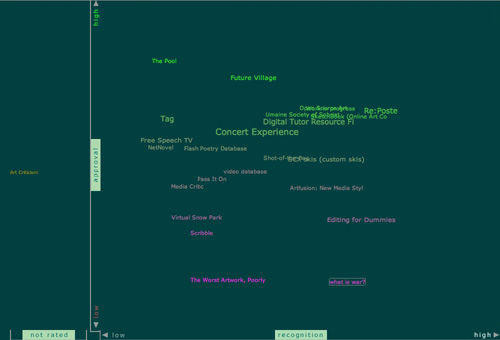About this project
Version 1.1 launched May 22, 2006
GAM3R 7H30RY 1.1 is a networked book. The Institute for the Future of the Book created this project to investigate new approaches to writing in the networked environment, and to see what happens when authors and readers are brought into conversation over an evolving text.
GAM3R 7H30RY 1.1 — the book and the web site — is a work in progress. We expect it to change over time. How exactly it changes is up to you. The feedback you give, the conversations you join, the discussions you start elsewhere on the web and out in the world — all could have an impact on subsequent stages of this book, or at least help to shape its larger context. Our hunch is that a good conversation generated here will result in a better book.
The Institute wanted to collaborate with McKenzie because we liked his last book, A Hacker Manifesto. We thought the ideas in that book were important. We also thought McKenzie was doing interesting things with the form of the books he was writing: exploring new structures beyond the page, searching for new distribution channels. GAM3R 7H30RY continues on this tack, building on the ideas in Manifesto and honing them to unlock the curious character of video games as allegories for the world we live in.
The book is also formally inventive. McKenzie composed this draft in a highly modular structure — nine chapters of 25 paragraphs each — presenting us with a very distinct set of design challenges. We created a site that works intimately with this form, providing what we hope is a pleasing and intuitive reading environment for the text.
It was our goal from the beginning to place the book and its discussion on an equal footing. We’d been thinking a lot about the problem of fostering equitable discussion in blogs, where comments tend to flow beneath a parent post and conversation is presented as subordinate or supplementary to the initial entry.
What if you didn’t have to click on a “comments” link to see the discussion? What if the comment areas in the book lived directly beside their corresponding sections? We made several attempts at a design that would accomplish this, documenting the process on our blog. Most of these we ended up scrapping, but we took some pictures along the way.
We had the idea for the card-shuffle interface one day when McKenzie came over to our office in Brooklyn for another round of brainstorming. We started prototyping with a sheet of paper and index cards, but by some sideways luck we pulled out a deck of Brian Eno and Peter Schmidt’s Oblique Strategies cards, which suited our needs perfectly. This is the resulting paper prototype (photo w/ wireframe cues photoshop’d in):

In addition to the book interface, McKenzie wanted a free-fire discussion area where people could introduce their own topics — about the book, but also about the specific games it references, and about the experience of game play in general. It would also be a place where people could talk about GAM3R 7H30RY 1.1 as a networked book experiment — how it succeeds, how it fails, and how it might be improved — inevitably broaching meta-subjects like cybertextuality, the future of books, and the design of virtual spaces.
We also wanted the discussion board to be more compelling than just a plain old list of topics, so we started thinking about interesting ways that the discussion could be visualized. Early on, McKenzie had the idea of a graph in which topics float along axes of time and quantity, giving some sense of the shape of the discussion. We liked this idea very much. Then we realized that it wasn’t our idea at all, that in fact some clever folks at the University of Maine had developed something quite similar called The Pool for collaborating on art, code and texts:
We decided to adapt this idea to our own purposes. We’re curious to see if it actually has an impact on the way people use the forum and on how they think about the conversations taking place there.
So there you have it: a book nested inside a feedback loop, an attempt at something new. Though GAM3R 7H30RY 1.1 represents only a fraction of what we think might be possible with networked books, we are very excited about this experiment and about the ideas McKenzie has brought forth. Eventually, when the book is “finished,” it will be published in print by a conventional press. By that time, however, we hope to have demonstrated how a book might be re-imagined as a process as opposed to a product.
* * * * *
GAM3R 7H30RY 1.1. is the latest in a series of “thinking out loud” experiments devised by the Institute to explore new modes of authorship in the network culture. The first, Without Gods: Toward a History of Disbelief, is a weblog by Mitchell Stephens of NYU devoted to his latest book project — a history of atheism eventually to be published by Carroll and Graf. Upcoming projects include a networked book on the city in the 21st century by Adam Greenfield, author of Everyware: The Dawning Age of Ubiquitous Computing.

